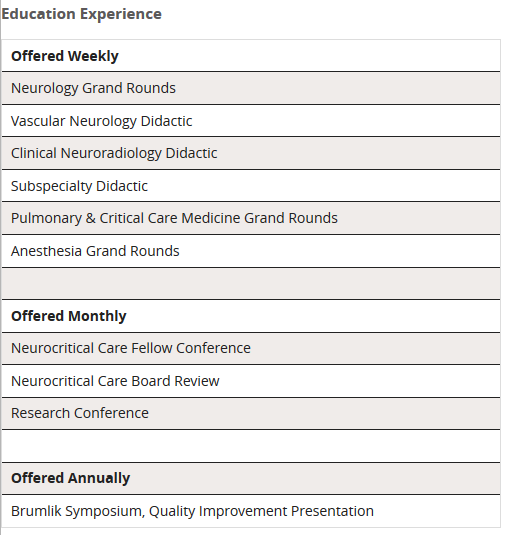Clinical Rotations, Education, Research Publications & More
Clinical Rotations

Neurology Intensive Care Service – Inpatient Rotation (NICU)
The fellow will spend four months during their first year of training and eight months during their second year of training on the NICU service.
Fellows work in a multidisciplinary team including a clinical pharmacist, a dedicated nurse practitioner, neurology resident and medical students. The bedside nurse actively participates in rounds.
The NICU team is involved in the care of all patients except uncomplicated spine patients and is consulted on traumatic brain injury patients with refractory intracranial hypertension or medical complexity.
Patients who receive IV tPA or embolectomy are managed post-procedure in the NICU.
Medical ICU Rotation (MICU)
The fellow will spend two months during their first year of training on the MICU.
Trauma/Surgical ICU Rotation (SICU)
The fellow will spend two months during their first year of training on the SICU.
Anesthesia Rotation
The fellow will spend one month during the first year of training on the anesthesia rotation.
Stroke Rotation
The fellow will spend one month during the first year of training with the Neurology Stroke Team.
Elective Rotation
The fellow will spend one month during their first year and three months during their second year of training.
The following electives are offered during the two-year training program:
- Transplant
- Burn
- EEG
- Transcranial Doppler Ultrasound (TCD)
- Endovascular Therapy
Fellow Education

Neurology grand rounds, covers a multiplicity of topics encompassing all of the program and faculty interest with a strongly weighted to: vascular neurology, neurocritical care, neuromuscular and epilepsy topics
The didactic curriculum covered varies but is important in the maintenance of neurology topics.
Vascular Neurology Didactic
Material covers the following cerebrovascular disease topics over an academic year: Infarction and ischemia, Intracranial hemorrhage, Subarachnoid hemorrhage, Dural Sinus thrombosis, Carotid-cavernous fistulae, and Cervical and cerebral arterial dissections.
Clinical Neuroradiology Didactic
Course material covers clinical neurophysiological related topics.
Subspecialty Didactics
Throughout the academic year will cover the following topics: neuromuscular disease, sleep, epilepsy and neurophysiology, pain management and other neurology topics
Pulmonary & Critical Care Medicine Grand Rounds
Topics cover a multiplicity of topics encompassing all of Pulmonary and Medical Critical Care.
Anesthesiology Grand Rounds
Topics cover a wide range of topics encompassing all of anesthesiology.
Neurocritical Care Fellow Conference
Lead and instruction by the fellow(s) which include didactic neurocritical care subjects covered by the board examination.
Neurocritical Care Board Review
Lead by neurocritical care board certified faculty.
Research Conference
Fellows will help facilitate, promote and conduct research related to subspecialty throughout the two-year program.
Division of Trauma, Burns, Surgical Critical Care Conference
Includes general trauma, burns and other surgical critical topics.
Scholarly Activity
Book Chapters
Bar, B. Hypertensive Encephalopathy. In: Caplan LR, Biller J, Leary MC, Lo EH, Thomas AJ, Yenari M, and Zhang JH, eds., Primer on Cerebrovascular Diseases, Second Edition, San Diego: Academic Press, 2017: 733-737.
Peer Reviewed Publications
Garg R, Bar B. Systemic Complications Following Aneurysmal Subarachnoid Hemorrhage. Curr Neurol Neurosci Rep. (2017) 17:7.
Cervenka MC, Hocker S, Koenig M, Bar B, et al. Phase I/II multicenter ketogenic diet study for adult superrefractory status epilepticus. Neurology. 2017 Mar 7;88(10): 938-943.
Presentations
Colletta KL, Bar B, Liebo MJ, Borys E, Schneck M, Gomez CR. Thrombectomy in VAD-originated Cerebral Embolism: Case Report, Contrast with Prior Experience, and Future Implications. Presented at 15th Annual Neurocritical Care Conference. Waikoloa, Hawaii; 2017.
Hextrum S, Ortiz J, Hornik J, Rosenblum J, Bar B. Emergent computed tomography angiography of intra- and extracranial vessels; ordering patterns and yield at a single institution. Presented at 142nd Annual Meeting of the American Neurological Association. San Diego; 2017.
Johnson B, Horsley L, Reed T, Quinones D, Siddall V, Balasubramanian N, Ray J, Friend P, Muccino K, and Ruland S. Poster Presentation: Simulation Based Medical Education in Interprofessional Education: Acute Stroke Management Model. International Stroke Conference, Houston, TX, 2017.
Johnson B, Horsley L, Reed T, Siddall V, Balasubramanian N, and Ruland S. Oral Presentation: Simulation in Interprofessional Education: Delivering TeamSTEPPS® and Early Stroke Management. The International Nursing Association for Clinical Simulation and Learning (INACSL) Conference, Washington, DC, 2017.
Colletta K, Kartha N, and Ruland S. Poster Presentation: An unusual case of hemichorea in a woman with newly discovered renal cell carcinoma and inconclusive LGI-1 antibody. The American Academy of Neurology 69th Annual Meeting, Boston, MA, 2017.
Local, Regional, National Invited Teaching Presentations
Ruland S, Invited Lecturer, Subarachnoid Hemorrhage, Neurology Grand Rounds, Loyola University Chicago-Stritch School of Medicine.
Ruland S, Invited Lecturer, Quality Improvement Update, Neurology Grand Rounds, Loyola University Chicago-Stritch School of Medicine.
Ruland S, Invited Lecturer, Cerebrovascular Disease II: Hemorrhagic Stroke Evidence-based Diagnosis and Management of Aneurysmal Subarachnoid Hemorrhage. The American Academy of Neurology 69th Annual Meeting, Boston, MA.
